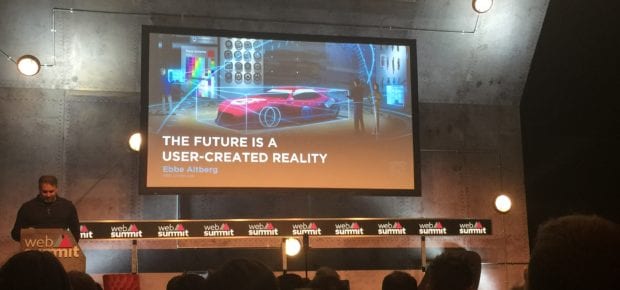November 4, 2015
In his panel titled, “The Future is a User-Created Reality,” Ebbe Altberg of Linden Lab walked the Content Stage audience through the very real applications of virtual reality.
Few industries are exempt from the benefits of virtual reality – Altberg kicked off by making the overarching point that VR will impact almost everything. His examples ranged between communication, business and education to health/wellness and commerce.
While the medium may be virtual, the benefits of VR are quite literal and real; VR creates a space for natural interaction in a non-physical space, and interaction is the basis for everything humans do.
Altberg shared a case study of an 88-year-old woman named Fran, who was diagnosed with Parkinson’s disease. Fran used virtual reality as a means of digital therapy – it afforded her mobility she no longer had to exercise and interact with people, and stimulated her brain in such a way that minimized her symptoms.
VR is so immersive that the brain cannot distinguish between virtual or physical experiences; over time, VR can conjure false memories with the ability to improve physical and mental wellbeing. VR has also been used to treat PTSD and phobias, as well as a medium for building support groups. Altberg suggested that the audience peek at research from Jeremy Bailenson of Stanford University.
In addition to healthcare, VR is revolutionizing education technology. Universities like Texas A&M are tapping into VR for chemistry instruction, and the technology also has application for broader science instruction like anatomy, biology, etc. Beyond classroom instruction, VR can also be leveraged as a tool for offsite learning, transporting students virtually to far away places like the Coliseum, or even the moon.
General consumers should be on the lookout for more virtual reality in commerce and enterprise. It’s not so far-fetched to assume that your workplace could eventually embrace VR technology for testing, training or customer service. VR is already becoming essential to careers that rely heavily on visualization, like architecture.
While not physical, the reality – no pun intended – behind VR is that it creates a sense of experience that will challenge and change how we communicate and how we live.
Brendan Iribe of Oculus VR said it best when he said that “this is the dawn of VR.” We can only go up from here, and Altberg expects that VR will take off in the same way that photo and video sharing.





 Meaningful Momentum or Running in Place?
Meaningful Momentum or Running in Place? AI Through Our Ages
AI Through Our Ages Liquid Infrastructure: Our Planet's Most Precious Resource
Liquid Infrastructure: Our Planet's Most Precious Resource The Impact of Technology in 2025
The Impact of Technology in 2025 Quantum and AI: Safeguards or Threats to Cybersecurity?
Quantum and AI: Safeguards or Threats to Cybersecurity? Why AI Can't Live Without Us
Why AI Can't Live Without Us Bits, Bytes, Buildings and Bridges: Digital-Driven Infrastructure
Bits, Bytes, Buildings and Bridges: Digital-Driven Infrastructure Impact of Technology in 2024
Impact of Technology in 2024 Emerging AI Cybersecurity Challenges and Solutions
Emerging AI Cybersecurity Challenges and Solutions The Skies are Unlimited
The Skies are Unlimited Smart Cities 2030: How Tech is Reshaping Urbanscapes
Smart Cities 2030: How Tech is Reshaping Urbanscapes Impact of Technology 2023
Impact of Technology 2023 Cybersecurity for Life-Changing Innovations
Cybersecurity for Life-Changing Innovations Smarter Wearables Healthier Life
Smarter Wearables Healthier Life Infrastructure In Motion
Infrastructure In Motion The Impact of Tech in 2022 and Beyond
The Impact of Tech in 2022 and Beyond Cybersecurity, Technology and Protecting Our World
Cybersecurity, Technology and Protecting Our World How Technology Helps us Understand Our Health and Wellness
How Technology Helps us Understand Our Health and Wellness The Resilience of Humanity
The Resilience of Humanity Harnessing and Sustaining our Natural Resources
Harnessing and Sustaining our Natural Resources Creating Healthy Spaces Through Technology
Creating Healthy Spaces Through Technology Exceptional Infrastructure Challenges, Technology and Humanity
Exceptional Infrastructure Challenges, Technology and Humanity The Global Impact of IEEE's 802 Standards
The Global Impact of IEEE's 802 Standards Scenes of our Cyber Lives: The Security Threats and Technology Solutions Protecting Us
Scenes of our Cyber Lives: The Security Threats and Technology Solutions Protecting Us How Millennial Parents are Embracing Health and Wellness Technologies for Their Generation Alpha Kids
How Millennial Parents are Embracing Health and Wellness Technologies for Their Generation Alpha Kids Space Exploration, Technology and Our Lives
Space Exploration, Technology and Our Lives Global Innovation and the Environment
Global Innovation and the Environment How Technology, Privacy and Security are Changing Each Other (And Us)
How Technology, Privacy and Security are Changing Each Other (And Us) Find us in booth 31506, LVCC South Hall 3 and experience the Technology Moon Walk
Find us in booth 31506, LVCC South Hall 3 and experience the Technology Moon Walk Virtual and Mixed Reality
Virtual and Mixed Reality How Robots are Improving our Health
How Robots are Improving our Health IEEE Experts and the Robots They are Teaching
IEEE Experts and the Robots They are Teaching See how millennial parents around the world see AI impacting the lives of their tech-infused offspring
See how millennial parents around the world see AI impacting the lives of their tech-infused offspring Take the journey from farm to table and learn how IoT will help us reach the rising demand for food production
Take the journey from farm to table and learn how IoT will help us reach the rising demand for food production Watch technical experts discuss the latest cyber threats
Watch technical experts discuss the latest cyber threats Explore how researchers, teachers, explorers, healthcare and medical professionals use immersive technologies
Explore how researchers, teachers, explorers, healthcare and medical professionals use immersive technologies Follow the timeline to see how Generation AI will be impacted by technology
Follow the timeline to see how Generation AI will be impacted by technology Learn how your IoT data can be used by experiencing a day in a connected life
Learn how your IoT data can be used by experiencing a day in a connected life Listen to technical experts discuss the biggest security threats today
Listen to technical experts discuss the biggest security threats today See how tech has influenced and evolved with the Games
See how tech has influenced and evolved with the Games Enter our virtual home to explore the IoT (Internet of Things) technologies
Enter our virtual home to explore the IoT (Internet of Things) technologies Explore an interactive map showcasing exciting innovations in robotics
Explore an interactive map showcasing exciting innovations in robotics Interactively explore A.I. in recent Hollywood movies
Interactively explore A.I. in recent Hollywood movies Get immersed in technologies that will improve patients' lives
Get immersed in technologies that will improve patients' lives